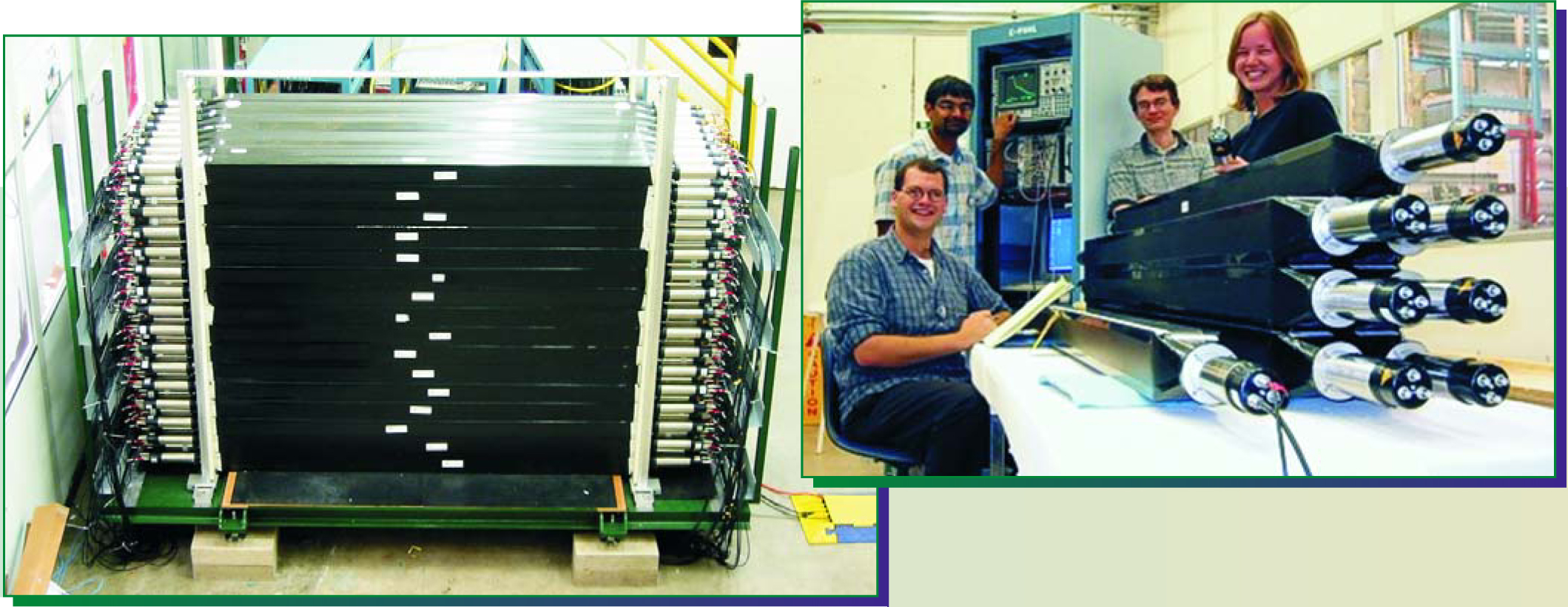Undergraduates Assemble Neutron Detector
DOI: 10.1063/1.1897555
“The undergraduates come running.” So says Ruth Howes about student participation in the Modular Neutron Array, or MoNA, a detector built in large part by undergraduate physics majors. Howes, chair of the physics department at Marquette University in Milwaukee, Wisconsin, says it is unusual and significant that students can work on MoNA without leaving their home institutions. The detector was installed last summer at the National Superconducting Cyclotron Laboratory (NSCL) at Michigan State University in East Lansing.
With MoNA, says MSU’s Michael Thoennessen, the project’s leader, “we can address one of the most interesting questions in heavy ion physics: For a given proton number, what’s the heaviest isotope you can make?” For oxygen, this limit—called the dripline for isotopes that persist for milliseconds—is 24O; with one more neutron, 25O lives only 10−21 seconds. An experiment planned for MoNA, Thoennessen adds, “is to take a beam of fluorine-26, which we can make here at the lab, and send it to a thin target, typically beryllium, to strip a proton. Then 26F becomes 25O, which decays immediately into 24O.” From the ejected neutron’s time-of-flight and position on the detector, “we can get the neutron’s energy and can reconstruct to show that 25O was created, how long it lived, and what its decay energy was,” says Thoennessen. The facilities offering the biggest competition for MoNA, he adds, are GSI in Darmstadt, Germany, RIKEN in Tokyo, and GANIL in France.
Ranking right up with the project’s scientific potential is student involvement, which helped drum up funding. Recalls Jim Brown, a physicist at Wabash College in Crawfordsville, Indiana, “At a users’ meeting, I popped off with, ‘Nothing looks too difficult to assemble. We could get undergraduates.’ My idea was that it would involve my students—it would give my guys something to do that would be good. Michael Thoennessen called a couple of months later, and said yes.” NSF funded the project with more than $900 000, split among the 10 campuses that built MoNA.
Nontraditional students
The detector consists of 144 two-meter-long plastic scintillator bars arranged in 9 vertical layers of 16. Photons created when incident neutrons interact with the scintillator are recorded by photomultipliers at the ends of the bars. MoNA is sensitive to neutron energies from 50 to 250 MeV.
Perhaps the most novel aspect of the construction process was that students could work on MoNA from their home institutions. To be sure, some did go to NSCL through NSF’s Research Experience for Undergraduates program. But others signed on directly through their physics departments. “Increasingly, undergraduate physics departments are seeing non-traditional students,” says Howes. “One of my undergraduates had been a funeral director. He was 30 and had a steady girlfriend. Another had worked in industry and had a wife. They appreciate being involved in real, publishable research, but they can’t leave home the way 20-year-olds can, for the whole summer.”
A local presence on college campuses brings other benefits, Howes says. “Pieces of hardware were delivered to undergraduate institutions. That meant we had labs with equipment. This is far more interesting to a casual passerby than a work station.” As a result, she adds, it is easier to attract students and to obtain the internal grants and fellowships that “you depend on when you are at a small college.” MoNA members, in addition to MSU, Marquette, and Wabash, are Central Michigan University in Mt. Pleasant; Concordia College in Moorhead, Minnesota; Florida State University in Tallahassee; Hope College in Holland, Michigan; Indiana University at South Bend; Western Michigan University in Kalamazoo; and Westmont College in Santa Barbara, California.
Phil Voss, who began working on MoNA as a junior at Central Michigan University, describes a stint at MSU: “We had two hours of lectures every morning. We calibrated [the detector], did some dirty work, painted a couple of steel bars that slow down neutrons. I stayed an extra week, I enjoyed it so much.” Uchenna Onwuemene, who also worked on MoNA as an undergraduate, adds, “We learned about nuclear physics. We saw the cyclotron and learned the part the detector would play. We saw the big picture.”
Suitcase alternatives
At NSF, the MoNA collaboration is considered a big success, says Brad Keister, the foundation’s program director for nuclear and theoretical physics. “It’s an important part of experimental physics to build the things you measure with. And I don’t know anyone who is excited about ‘suitcase physics.’ In this case, at least part of the construction took place at the home institutions.” At the inauguration of the upgraded NSCL in 2001, he adds, “Bob Eisenstein [then NSF’s assistant director for mathematical and physical sciences] walked up to a poster [about MoNA] and said, ‘That’s what NSF is about.’ It’s difficult for big science in big institutions to partner with undergraduate institutions—especially several of them at once. To the credit of Michigan State, they figured out how to make it work.” The first data, a calibration run using helium-7, were taken last summer.
Now that the detector is in use, MoNA organizers want undergraduate involvement to continue. “We are preparing a new proposal for NSF,” says Thoennessen. “We’d like to have [students] analyze data, and to come here to Michigan for workshops.”

The Modular Neutron Array (left) was assembled by undergraduates (above) at Concordia College and nine other institutions.
THOMAS BAUMANN/MSU

More about the Authors
Toni Feder. tfeder@aip.org
